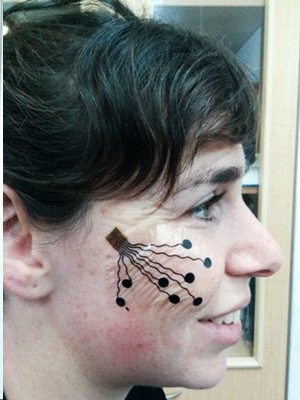|
NOVIDADES
A new temporary "electronic tattoo" developed by Tel Aviv University that can measure the activity of muscle and nerve cells researchers is poised to revolutionize medicine, rehabilitation, and even business and marketing research. The tattoo consists of a carbon electrode, an adhesive surface that attaches to the skin, and a nanotechnology-based conductive polymer coating that enhances the electrode's performance. It records a strong, steady signal for hours on end without irritating the skin. The electrode, developed by Prof. Yael Hanein, head of TAU's Center for Nanoscience and Nanotechnology, may improve the therapeutic restoration of damaged nerves and tissue -- and may even lead to new insights into our emotional life. Prof. Hanein's research was published last month in Scientific Reports ("Temporary-tattoo for long-term high fidelity biopotential recordings") and presented at an international nanomedicine program held at TAU.  Temporary-tattoo for long-term high fidelity biopotential recordings. Créditos: Tel Aviv University
"Researchers worldwide are trying to develop methods for mapping emotions by analyzing facial expressions, mostly via photos and smart software," Prof. Hanein continued. "But our skin electrode provides a more direct and convenient solution." The device was first developed as an alternative to electromyography, a test that assesses the health of muscles and nerve cells. It's an uncomfortable and unpleasant medical procedure that requires patients to lie sedentary in the lab for hours on end. Often a needle is stuck into muscle tissue to record its electrical activity, or patients are swabbed with a cold, sticky gel and attached to unwieldy surface electrodes. "Our tattoo permits patients to carry on with their daily routines, while the electrode monitors their muscle and nerve activity," said Prof. Hanein. "The idea is: stick it on and forget about it." "But that's not all," said Prof. Hanein. "The physiological data measured in specific muscles may be used in the future to indicate the alertness of drivers on the road; patients in rehabilitation following stroke or brain injury may utilize the 'tattoo' to improve muscle control; and amputees may employ it to move artificial limbs with remaining muscles." American Friends of Tel Aviv University, Posted: Jul 11, 2016. |
|||||||||||||||||||||||||